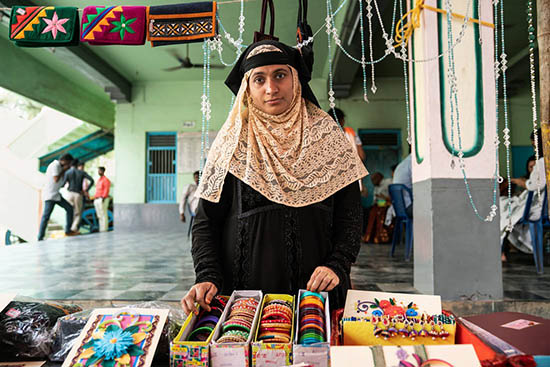谷歌在印度:希望,、夢想和機(jī)遇
|
即使坐擁如此多新產(chǎn)品,,谷歌的印度業(yè)務(wù)要想盈利還需等待數(shù)年,。盡管印度互聯(lián)網(wǎng)用戶數(shù)量激增,但觸及那罐金子仍然是一件難事,,需要印度中產(chǎn)階級大規(guī)模擴(kuò)張,。“每個(gè)人都認(rèn)識到,,印度是下一個(gè)10億用戶的來源地?!毙碌吕锟萍夹侣勯T戶網(wǎng)站MediaNama的創(chuàng)始人尼克爾·帕瓦表示,。“但印度還不是一個(gè)能夠創(chuàng)造可觀收入的地方,?!敝辽倌壳斑€不是?!捌髽I(yè)需要從20年,、30年的時(shí)間跨度來看待印度業(yè)務(wù),而不是10年,?!?/p> 對谷歌很幸運(yùn)的一點(diǎn)是,其印度戰(zhàn)略迄今一直在淡化利潤,。莫迪總理正在推行一項(xiàng)旨在打造“國家龍頭企業(yè)”的電子商務(wù)新政,。這項(xiàng)政策已經(jīng)遏制了亞馬遜和沃爾瑪在印度的發(fā)展勢頭。更重要的是,,谷歌至少含蓄地凸顯了其印度業(yè)務(wù)的“助力”色彩,,而并沒有一門心思地專注于商業(yè)化。它希望借此在印度民眾和公司內(nèi)部傳播善意,。在當(dāng)?shù)氐墓雀韪吖苤?,你可以明顯感覺到,他們認(rèn)為自己正在做善事,。 |
EVEN WITH THIS PROFUSION of new products, Google will need to wait years for its India operations to be profitable. Despite the rocketing numbers of Indian Internet users, reaching that pot of gold will be difficult and will need a sizable expansion of India’s middle class. “Everyone recognizes that India is where the next billion users are coming from,” says Nikhil Pahwa, founder of the MediaNama tech-news portal in New Delhi. “But India is not where substantial revenue will come from,” at least not yet. “Companies are looking at it from a 20-, 30-year horizon, not 10 years.” In a way, Google is fortunate its India strategy so far has downplayed profits. Prime Minister Modi is pushing a “national champion” e-commerce directive that already has stymied Amazon and Walmart. What’s more, by focusing at least implicitly on helping rather than on commercializing, Google is trying to spread goodwill, both among the Indian populace and within its own ranks. Among executives on the ground, there is a palpable sense that they are doing good. |

|
在世界上其他地方,谷歌與各路敵手的分歧越來越大,。比如,,讓人權(quán)組織感到憤怒的是,谷歌有可能在中國審查其搜索引擎,;歐洲監(jiān)管機(jī)構(gòu)援引反壟斷法,,對谷歌處以數(shù)十億美元罰款,。甚至在印度,谷歌也未能免于審查,。路透社在2月中旬報(bào)道稱,,印度反壟斷機(jī)構(gòu)正在調(diào)查谷歌涉嫌濫用其安卓手機(jī)操作系統(tǒng)的壟斷地位。 即使如此,,谷歌在印度的高管們?nèi)匀谎笠缰昂芄雀枋降摹睙崆?。“互?lián)網(wǎng)的力量在于,,你會突然意識到自己身上的潛能,。”該地區(qū)業(yè)務(wù)負(fù)責(zé)人阿南丹這樣說道,。這聽起來像是“科技抵制潮”(techlash)一詞在硅谷廣為流行之前發(fā)出的聲音,。他講述了印度村民在網(wǎng)上出售工藝品,偏遠(yuǎn)地區(qū)家庭訪問教育網(wǎng)站的故事,?!拔覀冋幱诨ヂ?lián)網(wǎng)在世界上發(fā)揮積極作用的起點(diǎn)上?!?/p> 谷歌為做善事而付出的諸多努力,,也有可能幫助它斬獲靚麗的業(yè)績。2014年,,該公司與印度國家鐵路服務(wù)公司合作,,推出“谷歌站點(diǎn)”(Google Station),為每天乘坐火車的約 2300 萬人安裝 Wi-Fi 熱點(diǎn),。自那以后,,谷歌已經(jīng)在400個(gè)印度火車站安裝了熱點(diǎn)。最近,,谷歌在墨西哥的公交車站和拉各斯的公共廣場推出了類似服務(wù),。善行必有善報(bào)。每當(dāng)用戶訪問谷歌站點(diǎn)時(shí),,一個(gè)門戶網(wǎng)站會收集他們的數(shù)據(jù),,并允許谷歌在專用網(wǎng)頁上發(fā)布廣告。盡管如此,,谷歌的高管們還是用曖昧的慈善詞匯來描述這個(gè)項(xiàng)目,。“這是一種奇妙的連接方式,?!鄙牌账f。 一些貧窮的印度工人非常喜歡使用這種免費(fèi)且快速的Wi-Fi上網(wǎng),。一天下午,,在印度南部喀拉拉邦擁擠的科欽火車站,,40歲的搬運(yùn)工曼尼坎丹告訴我,他最近利用谷歌站點(diǎn)為準(zhǔn)備迎接公務(wù)員的妻子下載了試題樣本,。曼尼坎丹在那里工作了10年,。“她通過了,?!彼吲d地說。 谷歌對新用戶的渴望,,碰巧與它的慈善努力重疊在一起,。事實(shí)上,谷歌已經(jīng)因其“Saathis”(印地語中“朋友”的意思)項(xiàng)目而名揚(yáng)印度,。該項(xiàng)目于2015年啟動,,旨在吸引更多女性上網(wǎng)。在印度的互聯(lián)網(wǎng)用戶中,,女性只占很小的比例。 |
Elsewhere in the world, Google is increasingly at odds with various antagonists, from human rights organizations peeved that Google might censor its search engine in China to European regulators who have fined Google billions of dollars over antitrust concerns. Google isn’t immune from scrutiny in India, either. In mid-February, Reuters reported that Indian antitrust authorities are investigating Google for alleged abuses on its Android mobile operating system. Even so, executives in India still bubble over with “Googley” enthusiasm. “The power of the Internet is you suddenly get ideas about what you can do,” says Anandan, the regional chief, sounding like a voice from a time before the word “techlash” became fashionable in Silicon Valley. He tells anecdotes about Indian villagers selling their crafts online and families in remote areas logging on to education sites. “We are in day zero of what the Internet can do in the world in a very positive way,” he says. Google’s efforts to do good also hold the potential for it to do extremely well. In 2014 it launched Google Station, in a partnership with India’s national railway service, to install Wi-Fi hotspots for the 23 million or so people who ride trains every day. It has since installed hotspots in 400 Indian train stations. Recently, Google launched a similar service at bus stops in Mexico and public squares in Lagos. The beneficence has benefits. When users log into a Google Station hotspot, a portal sucks up their data and allows Google to post ads on a dedicated web page. Google executives nevertheless describe the project in borderline philanthropic terms. “It is a fantastic way to connect,” Sengupta says. Some of India’s poorer workers take advantage of the free, fast Wi-Fi. One afternoon in the crowded train station of Kochi, the main city in India’s southern state of Kerala, M.R. Manikandan, a 40-year-old porter who has worked there for 10 years, tells me he recently used Google Station to download sample exams for his wife’s civil service test. “She passed,” he says happily. Google’s yearning for new users fortuitously overlaps with its charitable efforts. Indeed, it has become famous in India for its program of Saathis—the Hindi word for friend—which it launched in 2015 to help draw more women online. Women make up a small percentage of Internet users in the country. |

|
谷歌攜手印度制造和零售巨頭塔塔集團(tuán)旗下的慈善機(jī)構(gòu)塔塔信托,,在印度各地20多萬個(gè)村莊招募了約6萬名所謂的“Saathi”女性志愿者,讓她們教其他女性上網(wǎng),。在印度東部靠近孟加拉灣的安得拉邦一個(gè)名叫Thotlavalluru的小村莊,,我采訪了一位Saathi志愿者。據(jù)她透露,,谷歌負(fù)責(zé)培訓(xùn)Saathi,,并給她們每人贈送一部智能手機(jī),而塔塔信托每個(gè)月會發(fā)放約40美元津貼,。谷歌聲稱,,Saathi志愿者迄今已培訓(xùn)了大約2200萬人(其中大部分是女性),幫助她們掌握了一些基本技能,,比如如何打WhatsApp電話,、如何在線支付賬單等等。
該項(xiàng)目的目標(biāo)是,,到今年年底前覆蓋約30萬個(gè)村莊,。一些Saathi志愿者和她們的培訓(xùn)生已經(jīng)抓住機(jī)會,利用新掌握的互聯(lián)網(wǎng)技能開辦了家庭作坊,。比如,,她們在YouTube上下載如何自制蜂蜜,如何給襯衫刺繡的教學(xué)視頻,。一天下午,,幾個(gè)婦女聚集在Thotlavalluru村的印度教寺廟外,,向我展示她們的商品?!拔以赮ouTube上學(xué)會了如何用線和石頭來裝飾手鐲,。”32歲的帕維恩·貝古姆說,。她的丈夫是一位虔誠的穆斯林,,不允許她外出打工。她現(xiàn)在把手鐲賣給當(dāng)?shù)氐目蛻??!昂芏鄫D女來我家學(xué)上網(wǎng)?!彼f,。“我最終將培訓(xùn)大約1200人,?!?/p> |
Google partnered with Tata Trusts, the philanthropic arm of India’s manufacturing and retail conglomerate, and recruited about 60,000 so-called Saathis, all women, in more than 200,000 villages across India, to teach other women how to get online. Google trained the Saathis and gave them each a smartphone, while Tata pays them a stipend of about $40 a month, according to one Saathi I spoke to in the tiny village of Thotlavalluru in Andhra Pradesh state in eastern India, near the Bay of Bengal. Google claims the Saathis have so far trained about 22 million people, mostly women, in basic skills like how to make WhatsApp calls and pay bills online.
It aims to reach about 300,000 villages by the end of this year. Several Saathis and their trainees have seized the chance to start cottage industries with their new Internet skills, downloading instructional videos on YouTube on how to make homemade honey or embroider shirts, for example. One afternoon in Thotlavalluru, several women gathered outside the Hindu temple of the village to show me their wares. “I learned how to decorate bangles with thread and stones on YouTube,” says Parveen Begum, 32, whose husband, a devout Muslim, did not permit her to work outside the house. She now sells her bangles to local clients. “Women come to my house to learn the Internet,” she says. “I will train about 1,200 people in the end.” |













